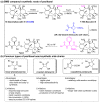Research Advances in Clinical Applications, Anticancer Mechanism, Total Chemical Synthesis, Semi-Synthesis and Biosynthesis of Paclitaxel
- PMID: 38005238
- PMCID: PMC10673093
- DOI: 10.3390/molecules28227517
Research Advances in Clinical Applications, Anticancer Mechanism, Total Chemical Synthesis, Semi-Synthesis and Biosynthesis of Paclitaxel
Abstract
Paclitaxel, a natural secondary metabolite isolated and purified from the bark of the Taxus tree, is considered one of the most successful natural anticancer drugs due to its low toxicity, high potency and broad-spectrum anticancer activity. Taxus trees are scarce and slow-growing, and with extremely low paclitaxel content, the contradiction between supply and demand in the market is becoming more and more intense. Therefore, researchers have tried to obtain paclitaxel by various methods such as chemical synthesis, artificial culture, microbial fermentation and tissue cell culture to meet the clinical demand for this drug. This paper provides a comprehensive overview of paclitaxel extraction, combination therapy, total synthesis, semi-synthesis and biosynthesis in recent years and provides an outlook, aiming to provide a theoretical basis and reference for further research on the production and application of paclitaxel in the future.
Keywords: anticancer mechanism; biosynthesis; paclitaxel; semi-synthesis; total synthesis.
Conflict of interest statement
The authors declare no conflict of interest.
Figures











Similar articles
-
Current Perspectives on Paclitaxel: Focus on Its Production, Delivery and Combination Therapy.Mini Rev Med Chem. 2023;23(18):1780-1796. doi: 10.2174/1389557523666230210145150. Mini Rev Med Chem. 2023. PMID: 36825714 Review.
-
[Advances in paclitaxel biosynthesis and transcriptional regulation mechanisms].Sheng Wu Gong Cheng Xue Bao. 2024 May 25;40(5):1380-1405. doi: 10.13345/j.cjb.230850. Sheng Wu Gong Cheng Xue Bao. 2024. PMID: 38783804 Review. Chinese.
-
Recent Developments and Anticancer Therapeutics of Paclitaxel: An Update.Curr Pharm Des. 2022;28(41):3363-3373. doi: 10.2174/1381612829666221102155212. Curr Pharm Des. 2022. PMID: 36330627 Review.
-
Research progress on the source, production, and anti-cancer mechanisms of paclitaxel.Chin J Nat Med. 2020 Dec;18(12):890-897. doi: 10.1016/S1875-5364(20)60032-2. Chin J Nat Med. 2020. PMID: 33357719 Review.
-
[Advances and prospects of taxol biosynthesis by endophytic fungi].Sheng Wu Gong Cheng Xue Bao. 2016 Aug 25;32(8):1038-1051. doi: 10.13345/j.cjb.150519. Sheng Wu Gong Cheng Xue Bao. 2016. PMID: 29022305 Review. Chinese.
Cited by
-
Plant sesquiterpene lactones.Philos Trans R Soc Lond B Biol Sci. 2024 Nov 18;379(1914):20230350. doi: 10.1098/rstb.2023.0350. Epub 2024 Sep 30. Philos Trans R Soc Lond B Biol Sci. 2024. PMID: 39343024 Review.
-
Recent advances in paclitaxel biosynthesis and regulation.J Exp Bot. 2025 Jan 1;76(1):124-133. doi: 10.1093/jxb/erae240. J Exp Bot. 2025. PMID: 38780282 Free PMC article. Review.
-
Post-genomic illumination of paclitaxel biosynthesis.Nat Plants. 2024 Dec;10(12):1875-1885. doi: 10.1038/s41477-024-01869-8. Epub 2024 Nov 27. Nat Plants. 2024. PMID: 39604636 Review.
-
Effects of Different Doses of sUV-B Exposure on Taxane Compounds' Metabolism in Taxus wallichiana var. Mairei.Int J Mol Sci. 2024 Jun 10;25(12):6407. doi: 10.3390/ijms25126407. Int J Mol Sci. 2024. PMID: 38928114 Free PMC article.
-
Self-assembly of paclitaxel derivative and fructose as a potent inducer of immunogenic cell death to enhance cancer immunotherapy.Mater Today Bio. 2025 Apr 23;32:101793. doi: 10.1016/j.mtbio.2025.101793. eCollection 2025 Jun. Mater Today Bio. 2025. PMID: 40343162 Free PMC article.
References
-
- Perez-Matas E., Hanano A., Moyano E., Bonfill M., Cusido R.M., Palazon J. Insights into the control of taxane metabolism: Molecular, cellular, and metabolic changes induced by elicitation in Taxus baccata cell suspensions. Front. Plant Sci. 2022;13:942433. doi: 10.3389/fpls.2022.942433. - DOI - PMC - PubMed
-
- Zefirova O.N., Nurieva E.V., Ryzhov A.N., Zyk N.V., Zefirov N.S. Taxol: Synthesis, Bioactive Conformations, and Structure-Activity Relationships in Its Analogs. Russ. J. Org. Chem. 2005;41:315–351. doi: 10.1007/s11178-005-0168-0. - DOI
Publication types
MeSH terms
Substances
Grants and funding
LinkOut - more resources
Full Text Sources

